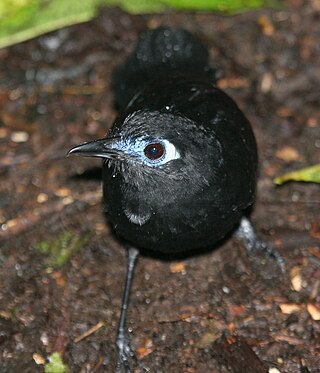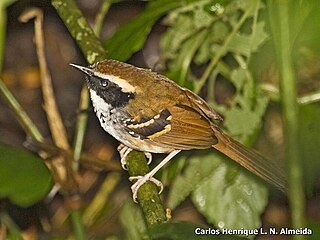
The white-bellied antbird, is a passerine bird which breeds in the tropical New World from Panama to northern Brazil and in Trinidad. It is also called Swainson's antcatcher after William John Swainson, who first described it scientifically. The genus is monotypic.

The bicolored antbird is a species of bird in subfamily Thamnophilinae of family Thamnophilidae, the "typical antbirds". It is found in Colombia, Costa Rica, Ecuador, Honduras, Nicaragua, and Panama.

The lunulated antbird is a species of insectivorous bird in subfamily Thamnophilinae of family Thamnophilidae, the "typical antbirds". It is found in Ecuador and Peru.

The rufous-throated antbird is a species of bird in subfamily Thamnophilinae of family Thamnophilidae, the "typical antbirds". It is found in Brazil, French Guiana, Guyana, Suriname, and Venezuela.

The white-throated antbird is a species of bird in subfamily Thamnophilinae of family Thamnophilidae, the "typical antbirds". It is found in Bolivia, Brazil and Peru.

Goeldi's antbird is a species of bird in the family Thamnophilidae. It is found in Bolivia, Brazil and Peru. Its natural habitat is subtropical or tropical moist lowland forests.

The blue-lored antbird is a species of antbird in the family Thamnophilidae. It is found at low levels in humid Andean forests in western and northern Colombia, western Venezuela. It formerly included the Zeledon's antbird as a subspecies. The blue-lored antbird feeds on insects, and regularly follows swarms of army ants in order to catch prey flushed by the swarms, but it is not an obligate ant-follower like some species of antbirds. The blue-lored antbird is strongly sexually dichromatic: the male has an entirely black plumage, while the female has a rufous-brown plumage and a black mask. Both sexes have a blue patch of skin around the eyes.

The white-shouldered antbird is a species of bird in the family Thamnophilidae. It is found in Brazil, Colombia, Ecuador, and Peru. Its natural habitat is subtropical or tropical swamps.

Myrmoborus is a genus of passerine birds in the antbird family, Thamnophilidae.

Myrmotherula is a genus of insectivorous passerine birds in the antbird family, Thamnophilidae. These are all small antbirds, measuring 9–11.5 cm (3.5–4.5 in).

The stipplethroats are a South and Central American genus of passerine birds in the antbird family Thamnophilidae. They were previously included in the genus Myrmotherula as the "stipple-throated group".

The harlequin antbird is a species of bird in subfamily Thamnophilinae of family Thamnophilidae, the "typical antbirds". It is endemic to Brazil.

The white-breasted antbird is a species of bird in subfamily Thamnophilinae of family Thamnophilidae, the "typical antbirds". It is endemic to Brazil.

Myrmelastes is a genus of passerine birds in the family Thamnophilidae. Most of these species were previously placed in the genus Schistocichla. The genus formerly included only three species, but several taxa previously considered subspecies of the spot-winged antbird have been elevated to species status.

The white-cheeked antbird is an insectivorous bird in subfamily Thamnophilinae of family Thamnophilidae, the "typical antbirds". It is found in Brazil, Colombia, Ecuador,and Peru.

Zeledon's antbird is a species of antbird in the family Thamnophilidae. It is found at low levels in humid forests from Nicaragua to Panama, and in the Chocó of western Colombia and western Ecuador. Zeledon's antbird feeds on insects, and regularly follows swarms of army ants in order to catch prey flushed by the swarms, but it is not an obligate ant-follower like some species of antbirds.

Myrmoderus is a genus of passerine birds in the family Thamnophilidae.

Akletos is a genus of passerine birds in the family Thamnophilidae.

Oneillornis is a genus of passerine birds in the family Thamnophilidae. The species are native to the Amazon rainforest of South America.


















